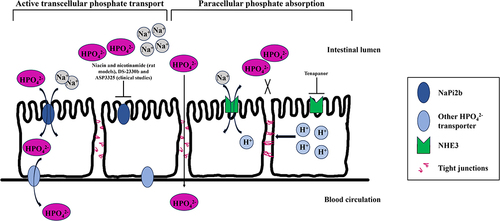Figures & data
Figure 1 Schematic representation of intestinal phosphate transport.
Notes: Phosphate is absorbed through two different mechanisms in the gastrointestinal tract. Active transcellular transport involves specific transporters such as the sodium-dependent phosphate 2b transport protein (NaPi2b), which can be inhibited by some molecules currently under evaluation for hyperphosphataemia management (Niacin and Nicotinamide in rat models, DS-2330b and ASP3325 in clinical studies). Passive paracellular phosphate transport happens through tight junction complexes along the concentration gradient and involves the sodium/hydrogen exchanger isoform 3 (NHE3), which transports sodium ions into cells in exchange for hydrogen ions; it has been reported that NHE3 inhibition by Tenapanor induces not only a sodium and water retention in the lumen but also an intracellular proton retention with following pH-related conformational change in specific tight junction proteins called claudins and reduction in the transepithelial permeability to phosphate.

Table 1 Clinical Trials Evaluating the Effects of Tenapanor in Haemodialysis Patients
